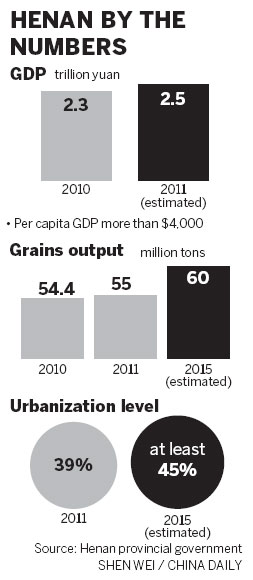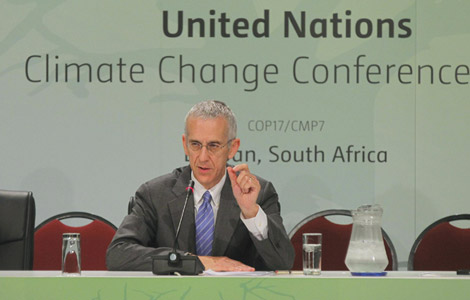Grain giant looks to tread new economic path
Updated: 2011-11-12 08:29
By Yan Jie (China Daily)
|
|||||||||||
BEIJING - Henan province, a major grain producer in Central China, will explore a new route for economic development while retaining its status as an agricultural heavyweight, it was announced on Friday.
According to the Guideline on Supporting Henan to Speed Up the Building of a Central China Economic Zone put forward late September, the province aims to achieve industrialization, urbanization and agricultural modernization, as well as protect the ecosystem and environment.
The key challenges facing the economic zone are low profit margins from grain and restricted land supply in Henan and neighboring areas, said Du Ying, vice-minister of the National Development and Reform Commission.

Last year, Henan contributed about one-tenth to China's annual grain output and one-fourth to the annual wheat output, official figures show.
"The grain output in Henan will reach 55 million tons this year," Governor Guo Gengmao said. "Henan bears a key responsibility in national food security."
The guideline states that authorities will encourage farmers to continue growing grain by spending more on agricultural production areas and offering more subsidies.
Meanwhile, it is believed that the restricted land supply will lead to further rules on arable land.
Although Henan accounts for about 6.5 percent of China's arable land, it is one of the most populous provinces, meaning arable land per capita is just 1.2 mu (800 square meters). Guo said about 6.8 million hectares is restricted for agricultural use.
However, the building of the economic zone will require a boost in urbanization, which means about 15 million farmers will be relocated in the next 10 years.
The governor said that, according to calculations, about 600,000 hectares of potential land could be found to support industrialization and urbanization in the economic zone by building land-saving village communities.
By the end of September, a million workers had been transferred from rural labor to non-agricultural sectors, Guo said.
Hot Topics
HIV/AIDS, Egypt protest, Thanksgiving, climate change, global economic recovery, home prices, high-speed railways, school bus safety, Libya situation, Weekly photos
Editor's Picks

|

|

|

|

|

|







